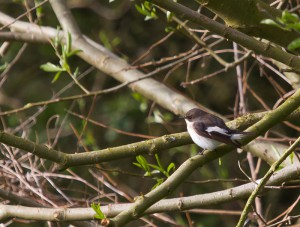After a bright sunny morning the weather clouded over and the first raindrops were felt just as three intrepid birders arrived to start the walk. By the footbridge there were Chiffchaffs, Blackcaps and a Lesser Whitethroat, so at least the warblers were not put off by the weather.
The rain came and went in short, light showers, so the weather was not too uncomfortable, as we made our way around the south western side of the Slurry Lagoon. There were lots of birds singing, making it sometimes difficult to point out a particular species, with Dunnocks, Wrens, Blackbirds, Song Thrushes and Robins joining the singing throng. A Willow Warbler perched up nicely so that everyone could see it as it sang its sweet cadence of descending notes. More Blackcaps were singing but they were much harder to see, and another Lesser Whitethroat was rattling out its song from deep in the hawthorns. Whitethroats were heard but they were giving their ‘churring’ contact notes and the only singing bird was rather distant, so we moved on towards the Causeway, where I hoped to find Reed and Sedge Warbler.
When we arrived by the reed bed there was such a hubbub of song that again individuals were hard to pick out. Then a Sedge Warbler started to perform and its staccato notes gave us no doubt of the performer’s identity. The Reed Warblers sang much more rhythmically with a more even range of notes. None of the birds were showing as they remained deep in the dried stems of last years reeds. A Whitethroat sang briefly from the Deep Pit but gave very poor views, and the Cetti’s Warbler song exploded from the bushes at the foot of the bank several times as it made its patrol.
All of this was soon forgotten as rain brought Swifts and House Martins low and their close passes above our heads completely stole the show. They seemed to go through in waves as first there were Swifts rocketing over the Causeway at head height, and then the House Martins could be heard giving their conversational ‘prrit’ calls as thirty or so were feeding higher up. Next some Swallows came though and then it was House Martins again. During this time the Swifts kept coming though, sometimes passing between peoples’ heads and Common Terns flew between the Deep Pit and Slurry Lagoon several times, calling excitedly as they pursued one that was carrying a fish. The Swifts were so impressive that it took us a long time before we could drag ourselves away.
We walked around the Deep Pit and back along its eastern side towards the river. On the bank by the river there were two Sedge Warblers singing loudly and a good view was grabbed of a male Whitethroat. On the fence we noticed some Swallows having a rest, so we paused until they decided to continue their journey, which was not very long. We tried to identify the males from the females. Some Sand Martins were feeding in the Deep Pit and we heard their rasping ‘trrrsh’ calls as some flew over towards the river. We carried on back towards the Causeway, hearing Willow Warblers, Chiffchaffs and Blackcaps singing along the railway embankment. Back on the Causeway we struck lucky as a Garden Warbler bubbled through its repertoire as it sat on an exposed perch and everybody got good views of it. The Swifts were still performing well, so we dawdled along the Causeway, hearing the Cetti’s Warbler again. It now began to rain more seriously and so we made our way off the site. We had missed one of the warblers, so we only scored nine. The Grasshopper Warbler has only been heard once or twice, very briefly, and is possibly not even on site this year.
